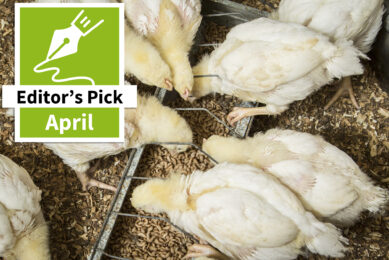ISU focuses on DDGS use in animal diets
Iowa State University researchers are working to safely increase feed use by cattle and poultry producers of DDGS, a co-product made during ethanol production.
The research by Mike Persia, Stephanie Hansen, assistant professors of animal science, and Dong Ahn, professor of animal science, is funded by the Iowa Power Fund
Persia’s research is focusing on egg laying hens. Currently diets only contain 5 to 8% DDGS. "What we’re trying to do with the research is look at ways to safely increase that percentage of DDGS in the diets."
Persia expects that the biggest changes occur in the yolk. "DDGS is high in lutein and unsaturated fatty acids, which might change the yolk composition of fatty acids," he says.
Another area Persia is focused on is how the DDGS will affect the waste products of poultry. DDGS are high in amino acids, which can break down into nitrogen in the chickens’ digestive system and can be excreted.
Excess nitrogen in the waste can led to increased evaporation of ammonia and can be an irritant that affects bird safety, human safety and the environment, according to Persia.
Including DDGS in feeds
DDGS cannot be put in front of the birds as is, because one might run into production and environmental impacts.
"It’s about working it into a balanced ration and finding out where that maximum is without affecting performance, environment, product quality, and human and bird safety," he says.
Maximised in cattle feed
Beef producers sometimes use up to 40% DDGS in cattle feeds. They don’t use more of this low-cost supplement due to its sulfur content. Too much sulfur in a bovine diet can be toxic.
"The problem in cattle is that DDGS have a lot of sulfur in them because ethanol producers use sulfuric acid in processing ethanol," Stephanie Hansen said. "We are looking into how much we can get into the diet without running into problems."
Because of the risk to the animals, Hansen’s research is first focused on developing methods to monitor sulfur levels in cattle. Her goal is to develop an easy-to-use, mobile test to determine when an animal is getting too much sulfur.
Variability is problematic
Since the ethanol industry is still fairly new, Persia says that feeding cattle and poultry the ethanol co-product DDGS is still not a science as they learn more and more about the feed ratios.
The researchers say one of the biggest hurdles is the variability in DDGS. The makeup of the DDGS varies in the percentage of fiber, oil, protein and sulfur from ethanol plant to ethanol plant and even within the same plant on different days.
Join 26,000+ subscribers
Subscribe to our newsletter to stay updated about all the need-to-know content in the feed sector, three times a week. Beheer
Beheer









 WP Admin
WP Admin  Bewerk bericht
Bewerk bericht